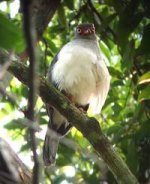
New Neotropical falcon
04-08-2003
A new species of raptor from the rainforests of south-eastern Amazonian Brazil, extreme eastern Bolivia and the Atlantic forests of eastern Brazil, has been found. The species has been named the Cryptic Forest-falcon Micrastur mintoni.
The paper’s author, Andrew Whittaker, heard an unfamiliar forest-falcon call whilst birdwatching at Caxiuanã, Pará, Brazil. Using tape playback, he saw the bird which closely resembled a Lined Forest-falcon M. gilvicollis, although there were a few subtle plumage differences.
Convinced he had found a new cryptic taxon, Whittaker subsequently examined forest-falcon specimens at the Museu Paraenese Emílio Goeldi in Belém, Brazil. There he found that 23 specimens matched the bird he had seen at Caxiuanã, whilst only 12 were correctly labelled as gilvicollis. Similarly, a search of museum sound archives revealed that many recordings were in fact attributable to the new species and not to gilvicollis, clearly confirming his earlier suspicions.
Apart from call, the main difference between the two species is the shorter tail and its patterning. Adult mintoni have one broad white central tail band, subadults have two broad white to buff bands. In contrast, adult and subadult gilvicollis have a longer tail with two distinctly narrower white tail bands, and immatures have two or three white to buff narrow bands. Other differences include mintoni’s more frequently contrasting dark forehead, crown and nape, slightly more extensive orange skin above the eye, bolder horizontal upper breast barring, less extensive lower underpart barring, and lack of a buff wash on the breast.
Currently the Amazonian population of Cryptic Forest-falcon is secure. The same is not true for the separate population in Brazil’s Atlantic forests, an area that has suffered extensive deforestation and is the focus of BirdLife’s Brazil Program. Further surveys are urgently needed to assess Cryptic Forest-falcon’s current status in this region, where it may already be extinct.
04-08-2003
A new species of raptor from the rainforests of south-eastern Amazonian Brazil, extreme eastern Bolivia and the Atlantic forests of eastern Brazil, has been found. The species has been named the Cryptic Forest-falcon Micrastur mintoni.
The paper’s author, Andrew Whittaker, heard an unfamiliar forest-falcon call whilst birdwatching at Caxiuanã, Pará, Brazil. Using tape playback, he saw the bird which closely resembled a Lined Forest-falcon M. gilvicollis, although there were a few subtle plumage differences.
Convinced he had found a new cryptic taxon, Whittaker subsequently examined forest-falcon specimens at the Museu Paraenese Emílio Goeldi in Belém, Brazil. There he found that 23 specimens matched the bird he had seen at Caxiuanã, whilst only 12 were correctly labelled as gilvicollis. Similarly, a search of museum sound archives revealed that many recordings were in fact attributable to the new species and not to gilvicollis, clearly confirming his earlier suspicions.
Apart from call, the main difference between the two species is the shorter tail and its patterning. Adult mintoni have one broad white central tail band, subadults have two broad white to buff bands. In contrast, adult and subadult gilvicollis have a longer tail with two distinctly narrower white tail bands, and immatures have two or three white to buff narrow bands. Other differences include mintoni’s more frequently contrasting dark forehead, crown and nape, slightly more extensive orange skin above the eye, bolder horizontal upper breast barring, less extensive lower underpart barring, and lack of a buff wash on the breast.
Currently the Amazonian population of Cryptic Forest-falcon is secure. The same is not true for the separate population in Brazil’s Atlantic forests, an area that has suffered extensive deforestation and is the focus of BirdLife’s Brazil Program. Further surveys are urgently needed to assess Cryptic Forest-falcon’s current status in this region, where it may already be extinct.





